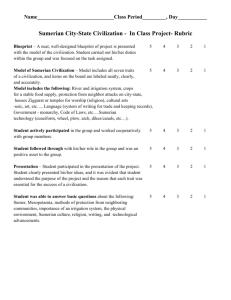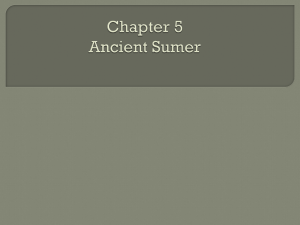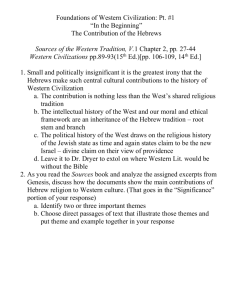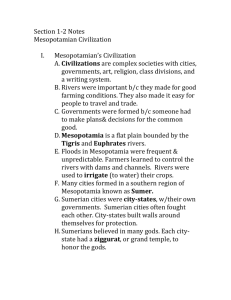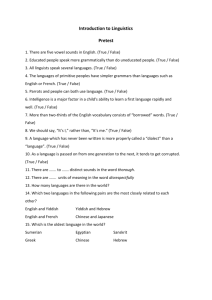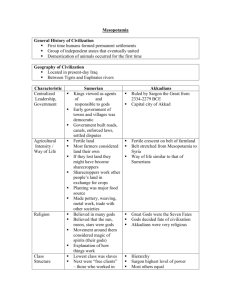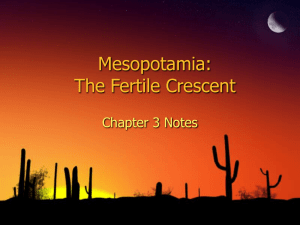SUMERIAN CULTURAL AND SCIENTIFIC ACHIEVEMENTS
advertisement
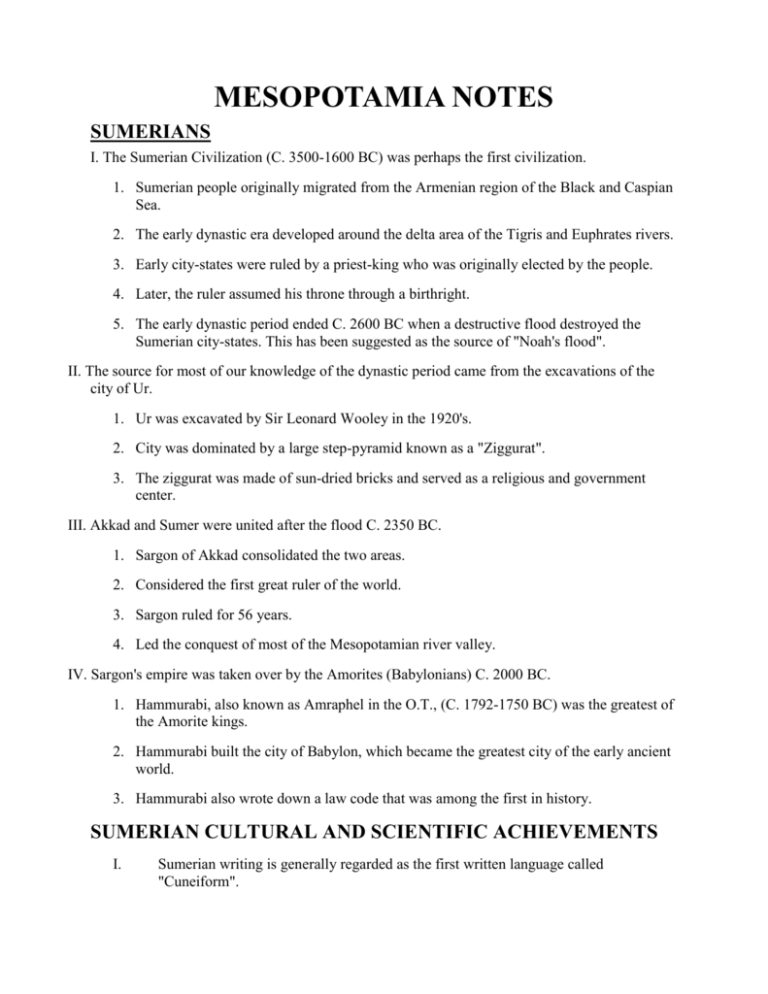
MESOPOTAMIA NOTES SUMERIANS I. The Sumerian Civilization (C. 3500-1600 BC) was perhaps the first civilization. 1. Sumerian people originally migrated from the Armenian region of the Black and Caspian Sea. 2. The early dynastic era developed around the delta area of the Tigris and Euphrates rivers. 3. Early city-states were ruled by a priest-king who was originally elected by the people. 4. Later, the ruler assumed his throne through a birthright. 5. The early dynastic period ended C. 2600 BC when a destructive flood destroyed the Sumerian city-states. This has been suggested as the source of "Noah's flood". II. The source for most of our knowledge of the dynastic period came from the excavations of the city of Ur. 1. Ur was excavated by Sir Leonard Wooley in the 1920's. 2. City was dominated by a large step-pyramid known as a "Ziggurat". 3. The ziggurat was made of sun-dried bricks and served as a religious and government center. III. Akkad and Sumer were united after the flood C. 2350 BC. 1. Sargon of Akkad consolidated the two areas. 2. Considered the first great ruler of the world. 3. Sargon ruled for 56 years. 4. Led the conquest of most of the Mesopotamian river valley. IV. Sargon's empire was taken over by the Amorites (Babylonians) C. 2000 BC. 1. Hammurabi, also known as Amraphel in the O.T., (C. 1792-1750 BC) was the greatest of the Amorite kings. 2. Hammurabi built the city of Babylon, which became the greatest city of the early ancient world. 3. Hammurabi also wrote down a law code that was among the first in history. SUMERIAN CULTURAL AND SCIENTIFIC ACHIEVEMENTS I. Sumerian writing is generally regarded as the first written language called "Cuneiform". II. Sumerian literature is among the earliest known writings. 1. The "Epic of Gilgamesh" is generally regarded as the greatest literature prior to the O.T. 2. Epic poem centered around the heroic tales of a great king. III. Hammurabi's law code was the earliest known law code in existence. 1. The code contained 282 laws. 2. Code was based on retribution, not justice. 3. Code was not fair between social classes. IV. Social Classes were similar to those in other early civilizations. V. Sumerian religion was the unifying and dominant force that provided the basic value structure of the society. 1. Sumerian civilization was characterized by polytheism, animism, and anthropomorphism. 2. Sumerians had a strong belief in life after death. 3. Sumerians also believed that each person had a "Ghost" which followed the individual at all times. 4. Earth was looked upon as a scary and gloomy place. 5. Priests used divination (fortune-telling), astronomy and temple prostitution to control society. 6. Sumerian gods were cruel and capricious. 7. Sumerian pantheon included (A) Enlil: ruler of all other gods represented by the air or wind; (B) Anu: the Sky god; (C) Enki or Ea: god of the earth and water; (D) Ishtar: referred to as the "Whore of Babylon" in the O.T., she was the goddess of love and fertility. VI. Sumerian art and architecture was ornate and complex. 1. While most cities were simple in structure, the ziggurat was one of the world's first great architectural structures. 2. Sumerians developed a complex system of sewers and flush toilets to rid cities of waste and unhealthy affects of swamps. VII. Sumerian scientific achievements were important to the modern world. 1. Sumerians invented the wheel C. 3700 BC. 2. Sumerians developed a math system based on the numeral 60, which is the basis of time in modern world. 3. Earliest concepts in algebra and geometry were formulated. 4. A system of weights and measures were developed which served the ancient world until the Roman period. 5. The Sumerians mapped many of the constellations. VIII. The Sumerian civilization ended when the Tigris Euphrates valley was overrun by the Hittites C. 1600 BC The Hittites and Phoenicians I. The Hittite civilization dominated Mesopotamia from C. 2000 BC to 1200 BC. 1. Hittites originally migrated from the Anatolia peninsula of present-day Turkey. 2. Hittites assimilated much from the Sumerian civilization. 3. Kings were warriors who were noted for the ferocity. II. The cultural achievements of the Hittites primarily occurred in the development of tools of war. 1. Hittites most remembered for the development of Iron that was used to forge new weapons. 2. Hittites created a new and improved three-wheeled chariot. III. Hittite civilization ended suddenly, C. 1200 BC, probably at the hands of the Assyrians. IV. The Phoenicians (Canaanites) had an important influence on the development of future civilizations. 1. Phoenicia was a loose confederation of city-states that grew up along the coast of present-day Lebanon and Israel C. 1000-700 BC. 2. The main city-states included Tyre, Sidon and Byblos. 3. These city-states were located on natural harbors. 4. This location made allowed Phoenicia to develop a large merchant trade. V. Phoenicia became known as the "Merchants of the Ancient Near East". 1. Phoenician trade centered around three products unique to their area; (A) Lumber (Cedars of Lebanon); (B) Glass; (C) Purple dye from the murex seashell. 2. Phoenicia established many new colonies along the Mediterranean coast to facilitate trade. 3. These included (A) Sardinia; (B) Sicily; (C) Malta; (D) Cadiz; (E) Carthage, which became the greatest and most important. VI. Phoenicia's cultural achievements were significant. 1. Religion included (A) the worship of Baal (God of Storms); (B) Human sacrifice; (C) Temple Prostitution; (D) Worship of fertility goddess known as Astarte who was similar to Sumerian Ishtar. 2. Major contribution, however, was the development of the first alphabet based on consonants and vowels (a phonetic alphabet). VII. Phoenicia was eventually conquered by the Assyrians, but their influence was evident for many centuries afterward. THE ASSYRIANS AND CHALDEANS I. The Assyrians conquered and overran most of Mesopotamia C. 900-612 BC. 1. Considered the most war-like and cruel people in the Ancient world. 2. At its height the Assyrian empire reached throughout the Fertile Crescent into Egypt. 3. 1st great capital was Assur, which gave the people its name. II. Four great Assyrian rulers stood between chaos and civilization and ruled with brute and deliberate power. 1. Tiglath-Pileser III (Pul) C. 746-727 BC, is the traditional founder of the Assyrians. 2. Sargon II, C. 721-705 BC, extended the empire to its greatest extent. 3. Sennacherib, C. 705-681 BC, created a new capital at Nineveh and destroyed Babylon and Jerusalem. 4. Ashurbanipal (Asnapper), C. 669-626 BC, was the last great Assyrian king and is noted for his cruelty and ferocity. III. The Assyrian government served as a model for future empires, especially the Persians and Romans. 1. Assyrians established many permanent roads to facilitate troop movement. 2. Established the first postal system to facilitate communications. 3. Hired many of its soldiers from foreign lands and paid them based on success (mercenaries). IV. Assyria was finally destroyed when several tribes united and formed an alliance to destroy it. 1. Nineveh was completely destroyed in 612 B.C. V. The Chaldeans, or Neo-Babylonians, briefly controlled Mesopotamia after the defeat of the Assyrians. 1. Chaldean era (612-539 BC) was dominated by one king, Nebuchadnezzar. 2. He also rebuilt the city of Babylon and constructed a palace that became one of the "Seven wonders of the Ancient World". 3. Babylon was captured in 539 BC by the Persians, ending the Chaldean era. THE HEBREW CIVILIZATION I. The Hebrew civilization flourished C. 1275-586 BC. Hebrew land, known today as Palestine (called Canaan by the Hebrews), was located in present-day Israel and east of Phoenicia. II. Early Hebrew history is outlined in the first five books of the Old Testament (the Torah) and attributed to Moses. 1. Abraham, from Ur, is regarded as the traditional founder of the Hebrews. 2. Some stayed in Palestine and were assimilated into the Phoenician culture while others settled in Egypt C. 1785 BC. 3. Time of Egyptian settlement corresponds with Hyksos invasion. 4. Hebrews were enslaved when the Hyksos were driven out C. 1575 BC. 5. Moses arose as a leader and forced the Pharaoh to "Let the People go" after a series of plagues including (A) turning the Nile to blood; (B) Frogs, lice and flies; (C) Murrain, boils and hail; (D) Locusts; (E) Darkness; (F) The death of the first-born of Egypt. 6. During the last plague the Hebrew were protected from the angel of death and this event was memorialized in the Jewish feast of the "Passover". 7. The pharaoh, probably Rameses II C. 1275 AD, allowed the Hebrews to leave Egypt in an event known as the "Exodus". III. The Hebrews establish a political kingdom in Palestine. a. Hebrews crossed the parted Red, or Reed, Sea and then wandered in the Sinai for forty years before settling in Palestine. b. Hebrews were divided into twelve tribes, each ruled by a "Judge" as outlined in the Book of Judges. c. Upon settling in Palestine, they were divided and independent. d. The last great Judge, Samuel, picked Saul to be the first "King of the Hebrews". e. Saul was succeeded by David, C. 1000-961 BC, who became the greatest of all Hebrew Kings. f. David noted for many accomplishments including (A) defeat of his enemies; (B) Making Jerusalem into his capital; (C) writing poetry (Psalms); (D) Restoration of the "Ark of the Covenant" to the temple. g. David was succeeded by his son, Solomon, C. 961-922 BC h. Solomon known for his wisdom as outlined in the book of Proverbs. i. Built a magnificent temple to house the ark of the covenant of which only one partial wall remains (The Wailing Wall). j. Solomon led a luxurious lifestyle and had 300 wives and 700 concubines. k. Solomon brokered peace treaties with the Egyptians and other Mesopotamian nations l. l. He eventually broke the kingdom and upon his death, Palestine was split into two parts. IV. The late Hebrew kingdom was split into two independent and individual kingdoms. The northern kingdom became known as Israel or Samaria. The southern kingdom became known as Judea. V. Eventually both Israel and Judea were overrun by the Babylonians and most Hebrews were enslaved, forced out of Palestine (The Babylonian Captivity) and their cities were destroyed C. 587 BC. VI. The Hebrew contributions to western civilization are of immense importance. 1. The laws set down by Moses, and known as Mosaic Law, is the foundation for all western law. 2. Their history was written down in the Torah and became known as the Old Testament and is usually cited as the most important work of the Ancient world along with the New Testament. 3. The Hebrew religion became the foundation for three of the largest religions in the western world. 4. Judaism, the traditional Hebrew religion, began as a war-like religion whose god, "Yahweh" or Jehovah, eventually grew into a loving and caring god. THE PERSIAN EMPIRE I. Persian Empire dominated Mesopotamia from 612-330 BC. 1. Persians originally located in present-day Iran. 2. At its height it was the largest empire until Alexander The Great conquered the known western world. II. The political history of Persia was dominated by four great and powerful kings. 1. Cyrus the Great (559-529 BC); Conquered most of the fertile crescent and ended the "Babylonian Captivity" of the Hebrews. 2. Cambyses, also known as Artaxerxes, (529-522 BC); Conquered Egypt but was alcoholic and was killed in a coup led by other family members. 3. Darius the Great (521-486 BC); The greatest of all the Persian kings. he extended the empires borders into India and Europe. He also fought two wars with the Greeks that were disastrous. He established a government which became a model for many future governments; (A) Established a tax-collection system; (B) Allowed locals to keep customs and religions; (C) Divided his empire into districts known as Satrapies (Imperial Bureaucracy); (D) Built a system of roads still used today; (E) Established a complex postal system; (F) Established a network of spies he called the "Eyes and ears of the King."(G) Built two new capital cities, one at Susa and one at Persepolis. 4. Xerxes (485-465 BC); He was the last great Persian king who led the final war against the Greeks but was defeated. These wars so weakened the empire that it was ripe for conquest by Alexander the Great. III. The Persian culture and religion has had a significant impact on western civilization. 1. Persians had a concept of "One World" and the "Unification of All People" which was taken up by Alexander, the Romans and future world powers. (Toleration for all) 2. The Persian religion, known as Zoroastrianism, was founded C. 600 BC by prophet Zoroaster. 3. Zoroaster wrote down his beliefs in a sacred book known as the "Zend Avesta." 4. The central theme of the religion is a belief in a struggle between good and evil. 5. Persians had a dual god system with "Ahura Mazda" (light) representing goodness and "Ahriman" (Darkness) representing evil. 6. The concept of heaven and hell also was important to the Persians. IV. The Persian empire ended when it was overrun by Alexander the Great in 331 BC.

